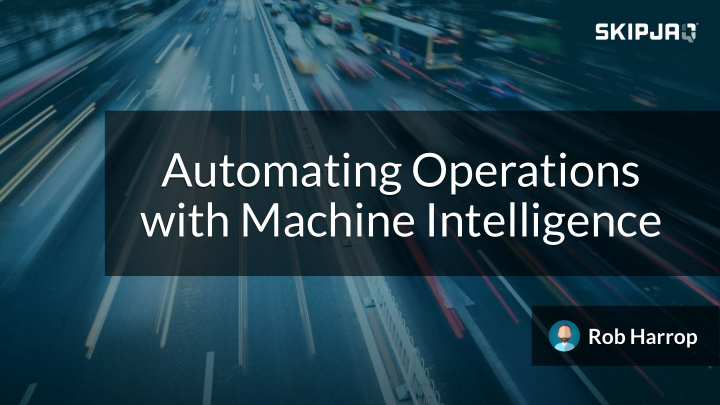



Automating Operations with Machine Intelligence Rob Harrop
CEO @ Skipjaq Co-founder @ SpringSource Automated performance management
Why automate operations? Why now? What does automated operations look like? How do we build for automation? Solving a real problem…
Why automate operations?
More Complexity
Monolith -> Microservices Strong -> Eventual Consistency Assume reliability -> Assume failure
More Deployments
40 30 20 10 Very end of 2009 Today Credit: Mike Brittain, Engineering Director @ Easy
Less time to identify fixes Rollbacks more likely Tiny window for human intervention
Harder Faster
Why now?
We have to
We can
Trends Cloud Containers Observability Microservices ML/AI
Current trends provide the impetus and tools for automation by AI
Automated Operations
Move 37
Move 78 - God’s Touch
AI Human
Types of Operation Actions Wholly performed by human Wholly performed by AI Co-operation between human and AI Actionable insight
On Metrics Data is not insight Gathering metrics is not automating operations But , metrics are critical to automating operations
Human ≠ Manual
Actions by Human Testing Deployment Provisioning
Cooperative Actions Anomaly alerting Rollback broken builds Dependency upgrade
Actions by AI Predictive auto scaling Workload placement Automatic rollback Performance optimisation? Security?
Actions and Actionable Insights
Building for Automation
Requirements for Operations Visible metrics and logs Ability to start/stop/restart/move workload Ability to change configuration Ability to modify dependencies Ability to wire/rewire external services
Self-contained package Disposable processes Externally-configurable Externally-observable Externalised dependencies Externalised service wiring
12+1 Factor
13 th Factor - Observability Metrics as event streams Standard metrics - CPU usage, memory usage, … Service-specific metrics - Leads received, items sold, …
Case Study Detecting Anomalous DB CPU
Background Consumer-facing web application running Rails against PostgreSQL on AWS RDS Mix of transactional and batch workloads running against the same database Question: when is the DB unusually overloaded?
Detecting Anomalies Policy-based Statistical model Predictive model Classification model
Policy Based Fixed threshold alerting How well does this work?
Not Very
Statistical Model Twitter AnomalyDetection package - Seasonal Hybrid ESD Is this point unexpected in our distribution? - With seasonal and trend effects removed
Statistical Model Stream Sliding window of observations Metrics (1 month, 1 year?) Each new observation run model (S - H - ESD) Is the new point an outlier?
Predictive Model Train a model to predict values in the time series Prediction error > critical value => outlier
x 1 a 1 (2) (2) a 2 x 2 (2) a 3 h W,b (x) x 3 Layer L 3 +1 +1 Layer L 1 Layer L 2
h 0 h 1 h 2 h 3 h 4 A A A A A x 0 x 1 x 2 x 3 x 4 From: http://colah.github.io/posts/2015-08-Understanding-LSTMs/
Predictive Model Metrics Stream Prediction Training set Model ?? last month Re-Train Is prediction error (Nightly, weekly?) an outlier???
Handling Anomalies Actionable alerts - Confidence in predictions No alerts for pointless things
Handling Anomalies Taking action - Rewiring services to read-replica? - Kill long-running queries?
Handling Anomalies Confidence in the model leads to confidence in automation
Summary Increasing complexity and deployment speed make operational automation a must We must build services that are ready for automation Simple models can often beat complex ones Cheap compute and storage makes large-scale ML available to everyone
Thank You
Recommend
More recommend